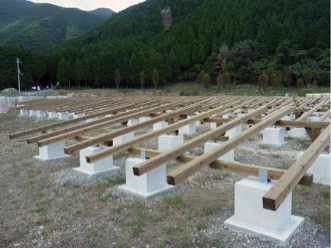PV installers in Japan are increasingly opting to use wooden racking for large ground-mounted installations as a way of improving overall environmental appeal and stimulate the local forestry industry.
Japanese companies, such as Sun Forest, Dainichi WoodPreserving, Kanematsu Nissan Norin and Sumitomo Forestry, are producing and selling materials for wooden PV racking all over the country, and with great success. Pressure-treated and preservative-coated timber produced by these manufacturers are specified to withstand 30 years of operation.
There are clear environmental benefits of using wood, as the embodied energy of timber is an order of magnitude lower than steel and aluminium. As a representative from Dainihon WoodPreserving puts it: “[wood matches] much better to [environmentally friendly] solar energy than steel.” However, the use of concrete as foundations detracts from this and needs to be minimised in order to retain this benefit. Some installers have even chosen not to apply preservative treatments so the wood can be used for biomass energy production at the end of its 20 year design life, again aiding in its environmental appeal.
Wooden PV racking made from excess Japanese cedar wood. Image Credit: Sun Forest via Nikkei Business Publications
Japan has 70% of its landmass covered in forest, so the use of local timber cleverly utilises this natural resource which, in turn, stimulates the local economy. For a particular installation at Fukushima–the Japanese prefecture known for bearing the brunt of the 2011 tsunami and ensuing nuclear disaster–locally-sourced wooden racking was chosen as the preferred construction material to do just that.
Analysts have estimated the cost of wood racking to be approximately US$320 per kilowatt of PV installed, compared to US$120 and US$280 for steel and aluminium, respectively. However, considering the cost of dismantling the system post-use helps to reduce the price differences between the wood and metal products.
It is uncertain what will happen if PV panels outlast their guaranteed 20–25 year deign life, in which case the wooden racking will likely need to be refurbished in some form. There are also the issues of potential wood rot, warping and twisting in extreme weather which can degrade system performance if monitored incorrectly.
There are genuine concerns regarding the safety of wooden racking systems, as the combustible material may aid fires generated externally or by electrical faults – this is a perfectly reasonable criticism. However, that argument can be made for any wooden structure. This includes every piece of wooden furniture you own, timber floor boards or perhaps you own a wooden house. By that logic, they are all a fire risk. Regardless, there are customers out there that would prefer to use wood rather than metal and what is nice about these developments is that it is giving PV consumers the option to use wooden racking if they so choose to.
Top Image Credit: Dainihon WoodPreserving Co. via Renewable Energy World
© 2014 Solar Choice Pty Ltd

can wood racks be used for cat 1 winds?